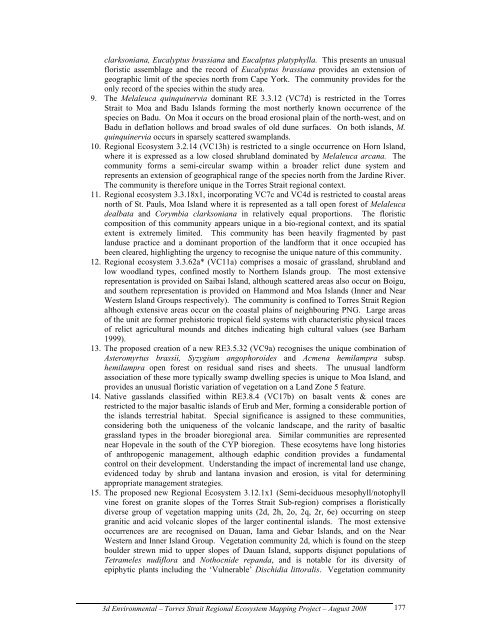Appendix 2 - Vegetation Communities and Regional Ecosystems
Appendix 2 - Vegetation Communities and Regional Ecosystems
Appendix 2 - Vegetation Communities and Regional Ecosystems
Create successful ePaper yourself
Turn your PDF publications into a flip-book with our unique Google optimized e-Paper software.
clarksoniana, Eucalyptus brassiana <strong>and</strong> Eucalptus platyphylla. This presents an unusual<br />
floristic assemblage <strong>and</strong> the record of Eucalyptus brassiana provides an extension of<br />
geographic limit of the species north from Cape York. The community provides for the<br />
only record of the species within the study area.<br />
9. The Melaleuca quinquinervia dominant RE 3.3.12 (VC7d) is restricted in the Torres<br />
Strait to Moa <strong>and</strong> Badu Isl<strong>and</strong>s forming the most northerly known occurrence of the<br />
species on Badu. On Moa it occurs on the broad erosional plain of the north-west, <strong>and</strong> on<br />
Badu in deflation hollows <strong>and</strong> broad swales of old dune surfaces. On both isl<strong>and</strong>s, M.<br />
quinquinervia occurs in sparsely scattered swampl<strong>and</strong>s.<br />
10. <strong>Regional</strong> Ecosystem 3.2.14 (VC13h) is restricted to a single occurrence on Horn Isl<strong>and</strong>,<br />
where it is expressed as a low closed shrubl<strong>and</strong> dominated by Melaleuca arcana. The<br />
community forms a semi-circular swamp within a broader relict dune system <strong>and</strong><br />
represents an extension of geographical range of the species north from the Jardine River.<br />
The community is therefore unique in the Torres Strait regional context.<br />
11. <strong>Regional</strong> ecosystem 3.3.18x1, incorporating VC7c <strong>and</strong> VC4d is restricted to coastal areas<br />
north of St. Pauls, Moa Isl<strong>and</strong> where it is represented as a tall open forest of Melaleuca<br />
dealbata <strong>and</strong> Corymbia clarksoniana in relatively equal proportions. The floristic<br />
composition of this community appears unique in a bio-regional context, <strong>and</strong> its spatial<br />
extent is extremely limited. This community has been heavily fragmented by past<br />
l<strong>and</strong>use practice <strong>and</strong> a dominant proportion of the l<strong>and</strong>form that it once occupied has<br />
been cleared, highlighting the urgency to recognise the unique nature of this community.<br />
12. <strong>Regional</strong> ecosystem 3.3.62a* (VC11a) comprises a mosaic of grassl<strong>and</strong>, shrubl<strong>and</strong> <strong>and</strong><br />
low woodl<strong>and</strong> types, confined mostly to Northern Isl<strong>and</strong>s group. The most extensive<br />
representation is provided on Saibai Isl<strong>and</strong>, although scattered areas also occur on Boigu,<br />
<strong>and</strong> southern representation is provided on Hammond <strong>and</strong> Moa Isl<strong>and</strong>s (Inner <strong>and</strong> Near<br />
Western Isl<strong>and</strong> Groups respectively). The community is confined to Torres Strait Region<br />
although extensive areas occur on the coastal plains of neighbouring PNG. Large areas<br />
of the unit are former prehistoric tropical field systems with characteristic physical traces<br />
of relict agricultural mounds <strong>and</strong> ditches indicating high cultural values (see Barham<br />
1999).<br />
13. The proposed creation of a new RE3.5.32 (VC9a) recognises the unique combination of<br />
Asteromyrtus brassii, Syzygium angophoroides <strong>and</strong> Acmena hemilampra subsp.<br />
hemilampra open forest on residual s<strong>and</strong> rises <strong>and</strong> sheets. The unusual l<strong>and</strong>form<br />
association of these more typically swamp dwelling species is unique to Moa Isl<strong>and</strong>, <strong>and</strong><br />
provides an unusual floristic variation of vegetation on a L<strong>and</strong> Zone 5 feature.<br />
14. Native gassl<strong>and</strong>s classified within RE3.8.4 (VC17b) on basalt vents & cones are<br />
restricted to the major basaltic isl<strong>and</strong>s of Erub <strong>and</strong> Mer, forming a considerable portion of<br />
the isl<strong>and</strong>s terrestrial habitat. Special significance is assigned to these communities,<br />
considering both the uniqueness of the volcanic l<strong>and</strong>scape, <strong>and</strong> the rarity of basaltic<br />
grassl<strong>and</strong> types in the broader bioregional area. Similar communities are represented<br />
near Hopevale in the south of the CYP bioregion. These ecosytems have long histories<br />
of anthropogenic management, although edaphic condition provides a fundamental<br />
control on their development. Underst<strong>and</strong>ing the impact of incremental l<strong>and</strong> use change,<br />
evidenced today by shrub <strong>and</strong> lantana invasion <strong>and</strong> erosion, is vital for determining<br />
appropriate management strategies.<br />
15. The proposed new <strong>Regional</strong> Ecosystem 3.12.1x1 (Semi-deciduous mesophyll/notophyll<br />
vine forest on granite slopes of the Torres Strait Sub-region) comprises a floristically<br />
diverse group of vegetation mapping units (2d, 2h, 2o, 2q, 2r, 6e) occurring on steep<br />
granitic <strong>and</strong> acid volcanic slopes of the larger continental isl<strong>and</strong>s. The most extensive<br />
occurrences are are recognised on Dauan, Iama <strong>and</strong> Gebar Isl<strong>and</strong>s, <strong>and</strong> on the Near<br />
Western <strong>and</strong> Inner Isl<strong>and</strong> Group. <strong>Vegetation</strong> community 2d, which is found on the steep<br />
boulder strewn mid to upper slopes of Dauan Isl<strong>and</strong>, supports disjunct populations of<br />
Tetrameles nudiflora <strong>and</strong> Nothocnide rep<strong>and</strong>a, <strong>and</strong> is notable for its diversity of<br />
epiphytic plants including the ‘Vulnerable’ Dischidia littoralis. <strong>Vegetation</strong> community<br />
3d Environmental – Torres Strait <strong>Regional</strong> Ecosystem Mapping Project – August 2008<br />
177


